Consequences of Vatican II
 |
 |
 |
 |
 |
 |
 |
Vatican Archbishop Commissions
Blasphemous Homoerotic Mural
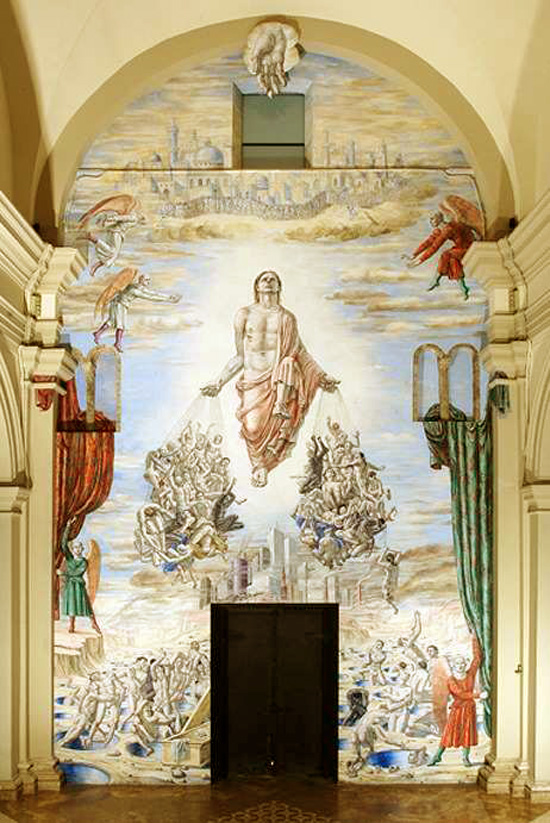
This mural has been on the Cathedral of Terni in Umbria, Italy, since 2007,
commissioned by Archbishop Vincenzo Paglia
Archbishop Vincenzo Paglia was recently appointed by Pope Francis as president of the Pontifical Pope John Paul II Institute for Studies on Marriage and Family.
The massive mural still covers the opposite side of the façade of the cathedral church of the Diocese of Terni-Narni-Amelia. It depicts Jesus carrying nets to heaven filled with naked and semi-nude homosexuals, transsexuals, prostitutes and drug dealers, jumbled together in erotic interactions.
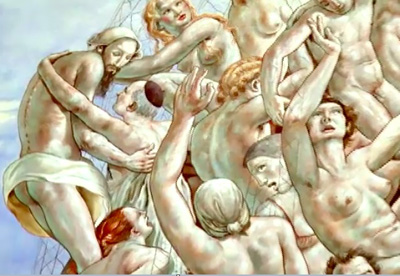
Paglia is embracing a male homo & touched by a lesbian's knee; below right, Leonardis with a tattoo
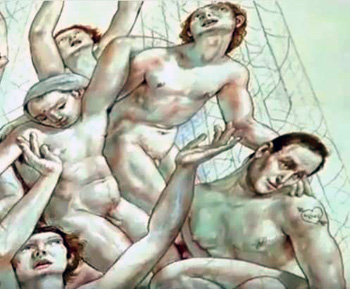
According to the artist, a homosexual Argentinean named Ricardo Cinalli who is known for his paintings of male bodies, Bishop Paglia selected him out of a list of 10 internationally-known artists specifically for the task of painting the inner wall of the façade. Bishop Paglia, along with one Fr. Fabio Leonardis, oversaw every detail of Cinalli’s work, according to Cinalli, who approvingly notes that Paglia never asked him if he believed in the Christian doctrine of salvation.
“Working with him was humanly and professionally fantastic,” Cinalli told the Italian newspaper La Repubblica in March of last year. “Never, in four months, during which we saw each other – almost three times each week – did Paglia ever ask me if I believed in salvation. He never placed me in an uncomfortable position.”
“There was no detail that was done freely, at random,” added Cinalli. “Everything was analyzed. Everything was discussed. They never allowed me to work on my own.”
Cinalli admits to La Repubblica that the naked people in the nets are meant to be “erotic,” although Bishop Paglia drew the line when Cinalli proposed to show people actually copulating.
“In this case, there was not – in this sense – a sexual intention, but erotic, yes,” said Cinalli. “I think that the erotic aspect is the most notable among the people inside the nets.” He later added, “the one thing that they didn’t permit me to insert was the copulation of two people within this net where everything is permitted.”
The reason he wasn’t allowed to be so explicit, says Cinalli, is that his painting had already done enough to demonstrate the notion that man has “freedom” in this life and even in the next, apparently to engage in whatever sexual behavior he deems appropriate.
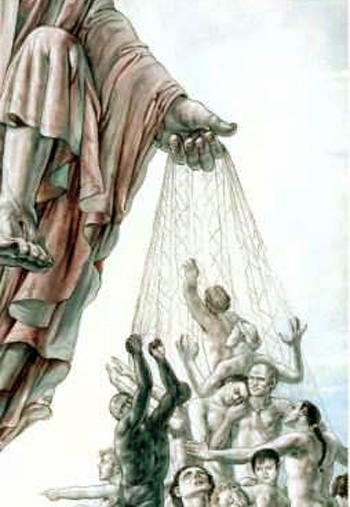
The artist says the people in the nets are meant to be "erotic"
The Catholic Church condemns all forms of sexual behavior outside of natural sexual intercourse between a man and a woman united in marriage, including homosexual sodomy, and warns that those who die unrepentant of such sins will suffer eternal damnation. The doctrine, which is found in the Old and New Testaments of the Bible, is reflected in the Catechism of the Catholic Church, which calls homosexual acts “intrinsically disordered,” and adds, “under no circumstances can they be approved.”
Under the supervision of Paglia, Cinalli painted the Bishop himself in one of the “erotic” nets, semi-nude and clutching a bearded man wearing nothing but a loose loincloth. He also painted Fr. Leonardis, then head of the Office of Cultural Heritage, as a naked, muscular man with a tattoo of a cupid’s arrow running through a heart containing the word “love,” entangled with others in one of the “erotic” nets.
Vatican appoints Paglia head of life and family issues
Although the mural generated controversy in Paglia’s Diocese, it passed under the radar of Italy’s national media, and Paglia’s promotion to Archbishop and appointment as President of the Pontifical Council for the Family in 2012 generated no controversy.
Soon, however, he began to give hints of his liberal attitudes regarding sexual morality, claiming in 2013 that the Catholic Church favors “legal protections and inheritance for people living together but are not married” and opposes making homosexuality a crime. When his comments received negative coverage from Catholic media, he claimed his intentions had been “derailed,” but didn’t retract the statements.
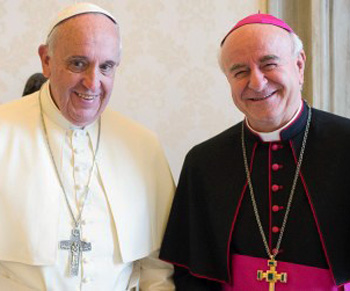
Francis rewarded Paglia by making him the head of the Pontifical Council for the Family
In July of 2016, still under the direction of Paglia, the Pontifical Council for the Family issued a new sex-ed program that includes lascivious and pornographic images so disturbing that one psychologist suggested that the Archbishop be evaluated by a review board in accordance with norms of the Dallas Charter, which are meant to protect children from sexual abuse.
“My immediate professional reaction was that this obscene or pornographic approach abuses youth psychologically and spiritually,” said Dr. Richard Fitzgibbons, a psychiatrist who has been a consultant to the Congregation for the Clergy at the Vatican and has served as adjunct professor at the John Paul II Institute for Studies on Marriage and Family at the Catholic University of America. “As a professional who has treated both priest perpetrators and the victims of the abuse crisis in the Church, what I found particularly troubling was that the pornographic images in this program are similar to those used by adult sexual predators of adolescents.”
In August of last year, Pope Francis moved Paglia from the Pontifical Council for the Family to the presidency of the Pontifical Academy for Life, as well as of the Pontifical Pope John Paul II Institute for Studies on Marriage and Family, two organizations founded by Pope John Paul II to defend the sanctity of human life and family values.
Soon it became apparent that the Academy was being radically transformed when new statutes were issued that no longer required members to sign a declaration of fidelity to the Catholic Church’s perennial teachings on the right to life. On February 17, it was confirmed that all Academy memberships had been terminated, leaving only Paglia and his staff at the top of an otherwise empty organization.
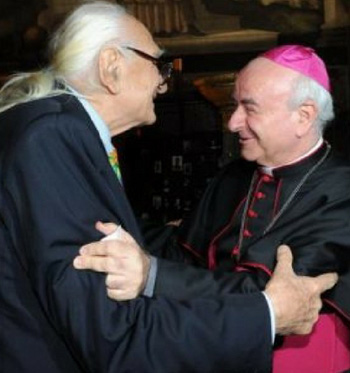
Arch. Paglia warmly greets Pannella, an atheist & promoter of pedophilia
Although Pannella had fought vigorously for the legalization of abortion, homosexual “marriage,” transgender “rights,” divorce, and free unions, and sought to dissolve the concordat between the Church and the Italian State, Paglia called him a “man of great spirituality” and said that his death was “a great loss, not only for the people of the Radical Party, but also for our country.”
“His story shows how a man can help history to go forward towards the defense of each and every person’s dignity, especially those who are marginalized,” said Paglia. “I take great pleasure in saying that Marco was truly a spiritual man who fought and hoped against all hope.” Paglia concluded, “we must receive and keep his (Panella’s) vitality.”
See the La Repubblica video of their interview with Ricardo Cinalli (in Spanish and Italian), which contains images of the mural [English subtitles by Tradition in Action]:
Matthew Cullinan Hoffman in LifeSiteNews.com on March 3, 2017

Posted March 10, 2017














